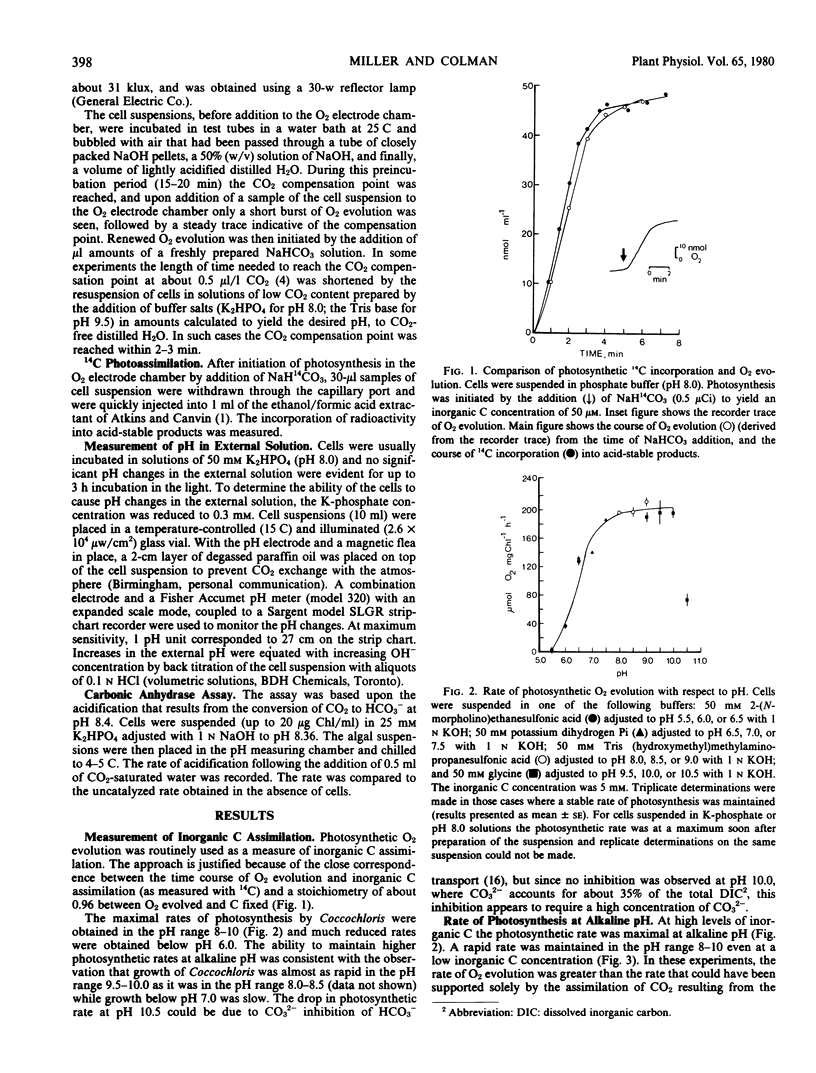Abstract
The possibility of HCO3− transport in the blue-green alga (cyanobacterium) Coccochloris peniocystis has been investigated. Coccochloris photosynthesized most rapidly in the pH range 8 to 10, where most of the inorganic C exists as HCO3−. If photosynthesis used only CO2 from the external solution the rate of photosynthesis would be limited by the rate of HCO3− dehydration to CO2. Observed rates of photosynthesis at alkaline pH were as much as 48-fold higher than could be supported by spontaneous dehydration of HCO3− in the external solution. Assays for extracellular carbonic anhydrase were negative. The evidence strongly suggests that HCO3− was a direct C source for photosynthesis.
Weakly buffered solutions became alkaline during photosynthesis with a one-to-one stoichiometry between OH− appearance in the medium and HCO3− initially added. Alkalization occurred only during photosynthesis and was blocked by 3-(3,4-dichlorophenyl)-1, 1-dimethylurea, diuron. It is suggested that HCO3− was transported into cells of Coccochloris in exchange for OH− produced as a result of HCO3− fixation in photosynthesis.
The inorganic C concentration required to support a rate of photosynthesis of half the maximum rate (Km) was 6 micromolar at pH 8.0 or, in terms of available CO2, a Km of 0.16 micromolar. This value is two orders of magnitude lower than reported Km values for the d-ribulose-1,5-bisphosphate carboxylase for blue-green algae. It is suggested that the putative HCO3− transport by Coccochloris serves to raise the CO2 concentration around the carboxylase to levels high enough for effective fixation.
Full text
PDF





Selected References
These references are in PubMed. This may not be the complete list of references from this article.
- Birmingham B. C., Colman B. Measurement of carbon dioxide compensation points of freshwater algae. Plant Physiol. 1979 Nov;64(5):892–895. doi: 10.1104/pp.64.5.892. [DOI] [PMC free article] [PubMed] [Google Scholar]
- Falkner G., Horner F. pH Changes in the Cytoplasm of the Blue-Green Alga Anacystis nidulans Caused by Light-dependent Proton Flux into the Thylakoid Space. Plant Physiol. 1976 Dec;58(6):717–718. doi: 10.1104/pp.58.6.717. [DOI] [PMC free article] [PubMed] [Google Scholar]
- Lucas W. J. Alkaline Band Formation in Chara corallina: Due to OH Efflux or H Influx? Plant Physiol. 1979 Feb;63(2):248–254. doi: 10.1104/pp.63.2.248. [DOI] [PMC free article] [PubMed] [Google Scholar]
- Masamoto K., Nishimura M. Estimation of internal pH in cells of blue-green algae in the dark and under illumination. J Biochem. 1977 Aug;82(2):483–487. [PubMed] [Google Scholar]
- Padan E., Schuldiner S. Energy transduction in the photosynthetic membranes of the cyanobacterium (blue-green alga) P-lectonema boryanum. J Biol Chem. 1978 May 10;253(9):3281–3286. [PubMed] [Google Scholar]
- Scholes P., Mitchell P., Moyle J. The polarity of proton translocation in some photosynthetic microorganisms. Eur J Biochem. 1969 Apr;8(3):450–454. doi: 10.1111/j.1432-1033.1969.tb00548.x. [DOI] [PubMed] [Google Scholar]
- Stanier R. Y., Kunisawa R., Mandel M., Cohen-Bazire G. Purification and properties of unicellular blue-green algae (order Chroococcales). Bacteriol Rev. 1971 Jun;35(2):171–205. doi: 10.1128/br.35.2.171-205.1971. [DOI] [PMC free article] [PubMed] [Google Scholar]


